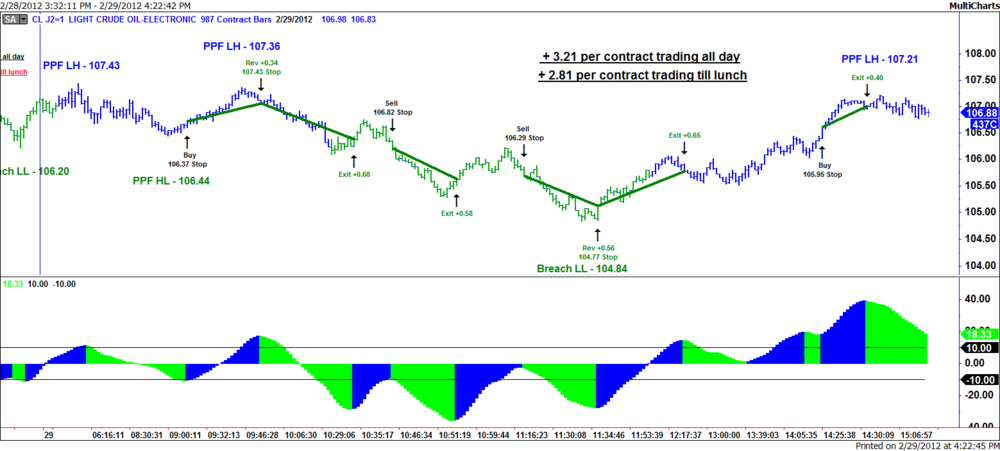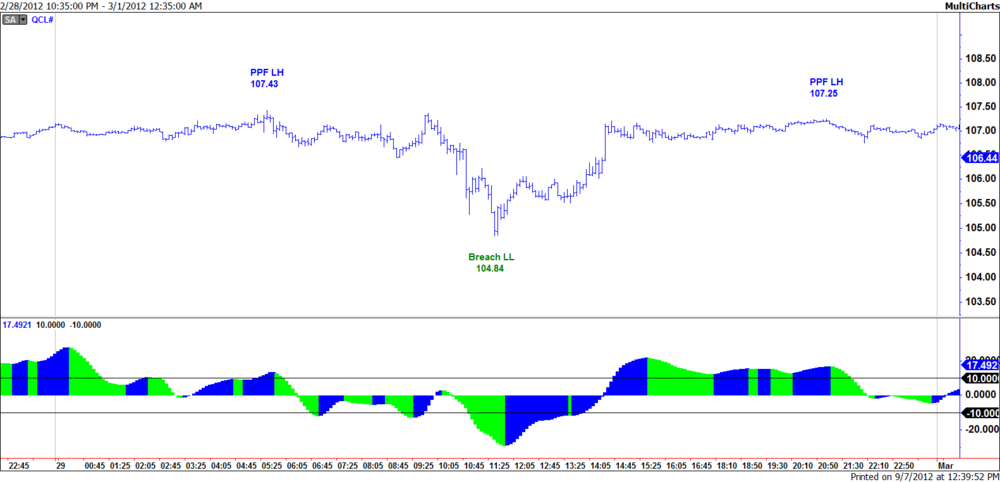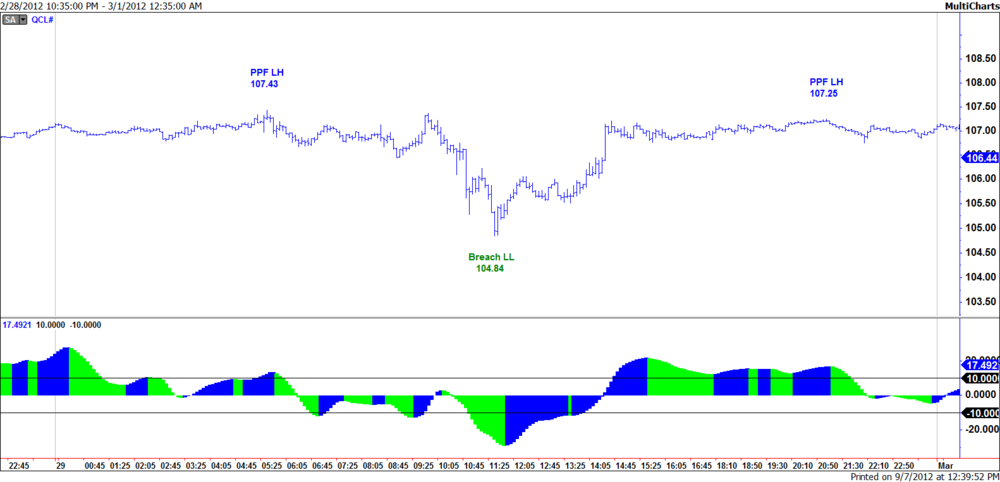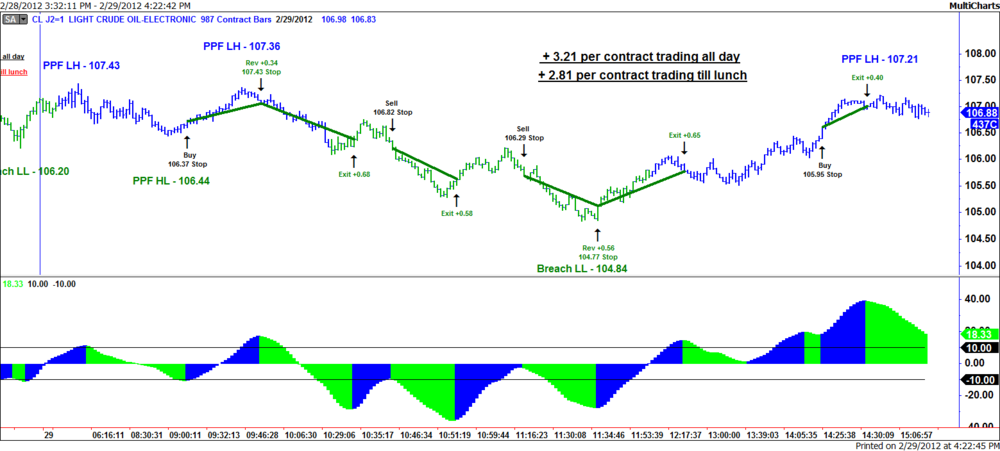Welcome to the new Traders Laboratory! Please bear with us as we finish the migration over the next few days. If you find any issues, want to leave feedback, get in touch with us, or offer suggestions please post to the Support forum here.
-
Content Count
131 -
Joined
-
Last visited
Posts posted by Logic
-
-
Is there any coding for any of Hershey's or Spyder's stuff? I'd like to test it using range bars. Thanks in advance.
-
Morpheus
Reading your posts are like reading quotes out of my book. The rear view mirror statement and trading what you see are my classics. Use them with my pleasure. :-)
They are great tidbits that most traders either don't understand or can't imagine how it applies.
I'll add a couple other options, if I may.
I personally and primarily stay away from daily stock charts, for trading decisions, because of their erratic behavior. I watch a basket of stocks but have learned to lightly speed up my view of their price action, using range bar charts, as to get a heads up on reacting to those nasty declines you talk about or even price ripping higher. I invented constant volume bars but have found range bars to be even more beneficial.
Nice to see some intelligence in reading price action. Well done!
-
HOW TO SAFETY TRADE TRENDS
All symbols are in a trend all of the time.
That statement will send a lot of people's sensibilities into a tail spin.
Allow me to explain.
Intraday a symbol might be in ugly consolidation but in a longer term swing or an even longer term position environment that same symbol might be in a solid UP or DOWN trend. The opposite will apply in the opposite direction as well.
The first step is to determine the chart increments (intraday, swing or long term position) and symbols (stocks, commodities, futures, ETF's or options) you are going to trade.
The second step is to specifically define what the term "TREND" means to YOU both visually and physically!
The third step is to look for YOUR confirmed trend on the basket of charts and symbols you monitor.
The fourth step is to monitor/track the oscillation pull backs & pull ups on those UP & DOWN trending charts so you can personally confirm the profitable outcomes of "buying pull back oscillation bottoms in YOUR confirmed UP trend & selling pull up oscillation tops in YOUR confirmed DOWN trend. (Once you are confident of those outcomes, after several months of chart watching, start trading small lot positions using the exact same parameters.)
The fifth step is go slow, grow slow, be steady, be consistent and be patient.
We shouldn't trade trends. We should trade the confirmed pull backs/ups on charts where we have confirmed "A" trend.
I only trade using CVB (Constant Volume Bar) charts because I've found them to be drastically more stable and smooth compared to time or range charting. I believe any time we can eliminate the potential of choppiness and consolidation from our charting, it is a huge plus.
I've posted a couple chart increments of the same day for the Light Sweet Crude symbol. One is a 5 minute chart and the other is a CVB chart. It's easy to see, visually the drastic difference between the two.
I hope this helps.
-
Looks like you have a solid understanding of price action but you could use an indicator to validate what is happening with price that is a lot more smooth. Let me know if you are looking, are interesting in looking or have looked into any different indicators. I have a couple suggestions but won't offer if you aren't interested in testing them.
WS
-
Don't get me wrong. I am NOT saying that CL is not a great tradable instrument, But to suggest that it is "safer" than the emini's is, in my opinion, ludicrous.I use a 4-6 tick stop successfully ES risking $50 - $75 per contract. In CL .. basically anybody who trade sit will agree that you need a min 10 and most likely 15 min tick stop risking $150 per contract.
If it were safer it would carry a lot smaller margin - but the margin is at least DOUBLE the ES. I guess the orginal poster I was replying to figures that the CME doesn't know how to set margin - or why?
In my environment, volume based charting, CL provides us a better win rate, less draw down, larger daily range, tighter stop placement (3 to 5 ticks) and more profit per trade than any of the Indices. To us, these equate to a safer trading environment.
I can see if you are trading the ES using time charts and the parameters you listed, then that is best for you but not everyone.
There are plenty of markets to trade and all kinds of systems and methods. This is what makes this such a great business.
Me, a data scientist, researcher and trader with going on 20 years of precise experience of charting and earning a living in this environment (with no experience in chemical engineering) telling JM Eagle how to improve their manufacturing of plastic pipes . . . now that is ludicrous. ;-)
-
You have GOT to be kidding right? Ever get into a CL trade and find yourself on the wrong side of a spike against you 50 - 100 ticks? Happens often in CL - NEVER in ES.Or SILVER the most lethal ball buster of them all.
Maybe you got them reversed?
Sorry, I've been trading CL for over 10 years and I've never experienced those 50 to 100 ticks spikes those of you that trade time based charts experience. I strictly use volume based charting.
That being said, in the last 12 years I've seen spikes in the ES as well, on time based charts, though not the range that the CL generates. Time based charts are a problem on there own due to news and other events creating unmanageable volume spikes in the market.
I've attached a couple charts for comparison. The first is a 5 minute chart that shows how a Crude report creates a nasty spike after its release. You can also see on the 5 minute chart that open to close there was no discernible difference in price. The second chart is the same day but is show using a constant volume based chart. No spikes just a steady smooth flow of readable momentum. Same range but a more safe and readable area for extracting profit.
-
After about 18 years of research in the futures and commodities arena I can say that the eMinis are no place for the faint of heart.
My group and I have done and are currently doing a lot of research on the volume and range associated with the specifics of price action on individual chart increments for over 800 unique symbols and over 100 stocks.
What we have discovered was that, on longer term swing or position charts, symbols level out regarding profitability.
The problems are in the "intraday" aspects of trading. In order to safely trade and extract profits from the commodity or futures markets, each day, the specific symbols need ample liquidity and volitility to be consistently profitable. Think about it like hitting a moving target that is 10 feet wide or 2 feet wide. The larger target is easier to hit just like the symbol with the larger volume and volitility is easy in capturing profits.
We find; Light Sweet Crude, Unleaded Gas, Silver, Gold and the Euro (not in any particular order) are the safest and most profitability. The second tier smbols are; Natural Gas, Australian Dollar, British Pound, Corn, Cocoa, eMini S&P Midcap 400 (ligher volume), Lean Hogs, Soybeans, Swiss Franc, US Treasury Bonds and Wheat (again, not in any particular order). The Indices; S&P, DOW, NASDAQ and Russell all came in at the bottom 10% of safety and overall profits.
-
Anyone still using this method?No one that anyone knows.
MERRY CHRISTMAS!!!!

-
Hopefully once your office build is complete you might find time to contribute here more regularly again - automated trading is somewhat under-represented on TL, I think.Regards,
BlueHorseshoe
We'll be fully in the new digs in January. I promise to participate more then. The automated side is my favorite.
-
Hi Logic,Thanks for your reply.
You're not here to promote your fund(s) (should they even exist) - I've tried to get that out of you in the past . . . and you're not here for idle chit-chat . . . One wonders why you come to TL at all?
Until next time . . .
BlueHorseshoe
I used to have a lot of free time while watching the markets and trading each day but over the last 18 months, time has gotten a light tighter. I really enjoy interacting with smart people in this field that like to shoot the $hit about stuff that effects them each day. It is the rude flaming morons that have driven me out of the forums though. Chit chat breaks up the routine of the day. Arguing with lower forms of functioning children is not fun. I've always considered you and your posts some of the brighter spots on here though.
We just bought a new office building and I have to manage the build out on the technology side. We are building a massive pedabyte server environment that is really a thing of beauty. By next Spring it will house all of our historic data for futures, FOREX, Options, ETF's, Stocks, and electric trading data all while being updated in real time. Backups are a real bugger. It is a lot of fun but I miss trading every day. I go hang out with the couple manual traders we have for a bit every day to "smell" the enthusiasm. Ninety percent of the trades we take each day are fully automated but the manual traders babysit the robots. We are adding a group of power traders as of December 1st to complete the diversity of the group and they are fully manual. This is getting more fun all of the time.
-
Hi Logic, i too would be interested in the above quote (I dont care about the returns but are more interested in what you mean) i saw a similar quote (I cant remember where) from AQR Capital and he talked about creating systems differently.Given you brought it up it seems unfair not to continue

Also just as an extra - I have always thought of any signal as being reactive from the point of view that everything is drawn from data in the past.....ie; there is not really any predictive signals. (even most fundamental analysis is similar, unless you are really trying to predict certain market trends, new innovations etc)
Slight semantics maybe/definately, and while i can understand that mean reversion systems (even if the mean is entering on trend reversals say) might be considered more 'predictive' as you are trying to pre-empt a move....I was wondering if this is a large factor in what you mean when you talk about creating systems?
I used to openly share what I do, I no longer feel so giving. Individuals like the mouse have poisoned those waters.
When I think of the differences between "reacting" and "predicting", I thnk of reaction points in models that produce consistent outcomes. I think of prediction points in models that produce chaotic random outcomes. This is the extent of what I will say onthe subject.
-
Hi Logic,I consider myself somewhat persuadable - please could you share a little about the easier approach to creating systems that you advocate?
BlueHorseshoe
Sorry, no.
I have to use 20 characters otherwise my answer would have been shorter.
Logic
-
Technical analysis is simply a toolbox. Some tools are more useful than others, all need to be used properly. What we use the tools for is to build something. What we build with technical analysis is predictive signals. We cannot blame tools for building a leaky roof and we cannot blame technical analysis for building a trading system that loses money.Understand that you can use those tools to build "Reactive" signals as well. Reactive signals are completely different than predictive signals.
You are absolutely correct when you say that, "we cannot blame technical analysis for building a trading system that loses money". The problem is that very very few people, including the high paid quants, know how to first define the environment they are trying to build signals into and second, they are clueless on how to make them consistently profitable over long periods of time.
I used to spend, literally hundreds of hours, trying to persuade people that were hard headed and "thick as a brick" that there was an easier way to create systems but I gave up. Now I co-manage 2 funds, one is a 1/3 billion dollar private fund that has been around for over 13 years and I just keep my mouth shut. We did over 15% last month in the one I am primary on and I consider that a shitty month.
-
TradersLaboratory decodes Primary Trend? I'm all ears at hearing someone else explain what I've wriiten about, documented and defined for over 15 years.
-
Hey TAMS, has anyone automated the method yet? Getting an answer to my previous question would be cool too, by the way, thanks
-
Yes, and that's basically the point I was making, here and in the other forum: I'm really not interested in hearing about 3% a month unless it's repeated consistently, month after month, year after year. Since no-one does this in practice, I would be happy to hear that you've outperformed the benchmark by 2% on average without major tracking error.People produce 3% a month or better on a regular basis but not trading stocks. Not that it coudn't be done it is because it is easier to produce those returns using the smaller margin requirements in the futures markets.
-
Shennanigans. If you can earn 3% per month after taxes and fees, then all you'd need is $32,000 and 40 years to have more money than Warren Buffett. Plenty of people have $32,000 and 40 years, so how come there's only four people who have $40bn?That is "IF" you find the need to continuously compound returns. I for one, don't. I found a saturation point for my personal trading that produces a comfortable profitability level without the stress of needing to create a Warren Buffett type of environment. Your statement is a perfect example of how greed and excess plays into one's opinion of this business and how common sense is never a meaningful consideration.
-
3 workarounds to doing it:1) (less precise): use futures contract equivilant fx contracts and calculate proportional volume into its spot FX equivilant. Also CME and other institutions may actually be starting to do some OTC transactions on an institutional level.
2) (broker-specific): measure the price difference per incoming tick. If they offer some sort of level II volume statistics, use it. I think FXOpen ECN, InstaForex (surprisingly), maybe MBTrading, Interactive Brokers, and maybe the newer tradestation feed does offer some sort of level II insight.
3) (broker-specific): see if you can get a feed with as many liquidity providers/brokers as possible / api access and get the actual level 2 volume as they keep track of it. Then you would compare the net price movement and net volume for each tick. Obviously this is the most accurate of the 3 and the most expensive/difficult.
The inherent problem with forex is that each individual broker "makes" the market available to its clients. much of the retail volume is aggregated and re-aggregated, plus there is a lot more that will never be shown in the higher-tier interbank markets, unless some of those providers start revealing real-time volume information.
Exchange traded products every tick is accounted for; so no problems getting accurate tick data. Forex brokers tend too "filter/smooth" their datafeeds. You'd be surprised how many actual ticks would come through if they didn't smooth the feed. But then there may be additional platform stability issues, etc. And for historical analysis, tick data is lacking from many brokers; forextester is one of few companies offering tick data collection.
If metatrader 5 had been what metatrader 4 was now, this data might have been more accessible already with more traders.
My APAMI indicator, which measures net distance between the current price and a previous price point, (qualified by retracements) did reveal some interesting aspects about how price really works. More on that hopefully by the end of this week :haha:
Thanks.
I was aware of #1, #2 isn't consistently accurate and #3 is a new approach we hadn't though of. Definately worth looking into.
We trade currency futures now because of the lack of accurate volume data in FOREX. The heads up is greatly appreciated.
-
The volume and the agreed price on each volume unit would be what you consider to be the "completed transactions"? Easy to do with exchange-traded products. OTC like forex is a little more tricky, but can be done.Correct, the price of each individual unit (share or contract) bought or sold.
I'd be really impressed if you told me you had been able to dig that information out of FOREX. I've heard it was embedded and hidden in the feeds but haven't ever been able to confirm that.
-
Fair enough. But you can still make money as an individual if you understand such behavior of funds.All I'm saying is that an individual trader can make money by gathering a few ticks here and there, whereas most funds need big(ger) moves to make money. This is an advantage we have over them. It's only one aspect, of course, but this is IMO always missing in performance comparisons of individual traders vs. funds.
The examples of some of the Market Wizards showed that their performance got worse the more money they managed. Now, you can attribute that to other aspects as well (or just good and bad luck). However, they themselves attributed it to the increased size they had to manage.
You are correct.
If trading decisions are made based on visually or algorithmically tracking completed transactions and not the bid/ask, this levels the playing field and it becomes irrelevant the size of the participants or the size of the trades in the specific market you are trading.
You are also correct in stating that there is a point or apex in regards to the amount of money one trades or a fund trades. There is a saturation point that each individual or entity needs to know like the back of their hand.
-
Why on earth would you pay taxes?It's simple enough to trade an account operating as a company domiciled in an off-shore jurisdiction. When you finally cease trading you then have two options:
1) Move the money back into your own tax residency as capital gains, at which point the 25% is less harmful than a 25% deduction on a yearly basis.
2) Move and live in the off-shore jurisdiction (or any other country with similar tax arrangements) - which shouldn't be a problem if your real returns were anything like the hypothetical ones I listed.
BlueHorseshoe
Blue,
The rodent probably thinks St. Croix is a foreign country too.
-
OOOOW! a hedge fund. They are smart. Imagine how smart you are if they are using your algorithms.I get the gist. Clearly, then, you are the smartest person on this site. I guess you weren't done with your story telling. Can you also snap a whip Indiana? I am glad you won't tell us or show us your results because I think our faces would melt. Just like in the movie when they were exposed to the holy grail.No one is as smart as you Mighty Mouse. I know you trade an account that size on your own, have balls of steel and the intellect of Arnold Schwarzenegger.
If you think 38% annual returns are impossible you are far more ignorant than anyone on this site ever imagined. Three closed listed private funds currently have audited documented returns in that neighborhood and have had for a number of years.
-
Some of us? I guess that list includes you which implies that you have the skills and have earned far greater than 3% a month. Of course this is something that we will never be able to seeI suppose that you can run mile in under 4 minutes, bench press 700 lbs and squat 1000 lbs. Why not? Spread the bullshit evenly. It looks cleaner. Most readers on TL do not like lumpy bullshit.
It is always refreshing to get a comic book view of trading.
I recently partnered to run a long established quarter billion dollar hedge fund based on them extensively testing my algorithms. They consistently produced returns greater than 3% monthly using my software but you are correct in stating "you will never see it". At least not the inner workings of it.
There are those, more intelligent individuals, that still believe testing wild statements might prove themselves out at some point as this fund did. They were extremely skeptical until they saw the results produced from their own traders utilizing the algorithms. Nothing like having the skeptical prove themselves wrong. They are my favorite converts.
You have a wonderful holiday Mighty Mouse reading your comic books.
-
You didn't say it but I will .... another reason, since most claims by others are dubious, at best.Not to be taken by anyone in particular as referring to them, but what the internet age is famous for.
Being skeptical is a really good thing and important to one's survival in this industry. Being narrow minded, close minded and arrogant will get one absolutely no where even faster.
If one can't balance their skepticism and curiousity then one needs to find another passion.







3 Ways to Confirm a Breakout
in Forex
Posted
Looks like a chapter from my book. Nicely done and stated Richard!